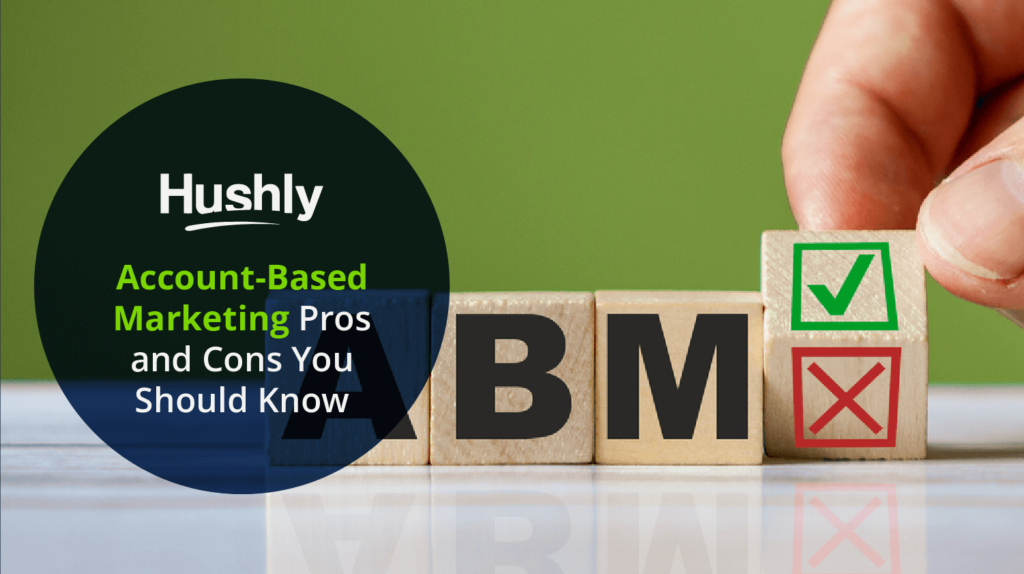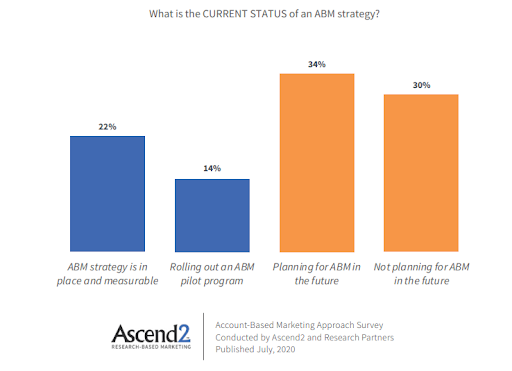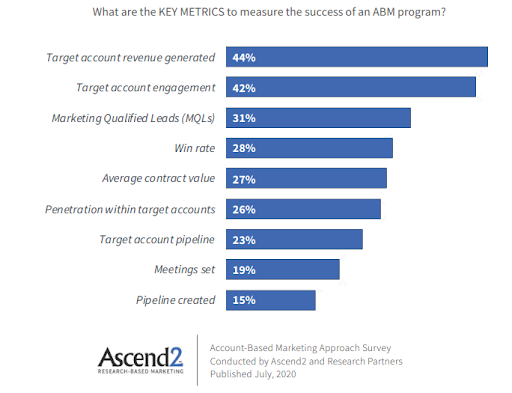Filters
Content Type
Topic
Account-Based Marketing Pros and Cons You Should Know
Account-based marketing (ABM) is a powerful strategy for B2B companies, but it’s not without its disadvantages. Before you invest in an ABM strategy, it’s essential to understand the pros and cons of this approach. By weighing up the positives and negatives of ABM, you can decide whether it’s worth investing in for your business.

Account-Based Marketing in 2023
The phrase account-based marketing was trending among B2B marketing professionals between 2019 and 2021, but then it trailed off a bit with all the news surrounding AI and machine learning in both content creation and marketing automation.
So, where does ABM stand in 2023? According to research across several sources, ABM is thriving and set to grow even more in the years to come. According to a report by Ascend2, only 22% of companies report having a measurable ABM strategy already in place. Another 14% say they’re currently in the process of implementing one, while 34% of marketers say they’re planning to implement ABM in the near future.

Source: Ascend2 via Convince & Convert
That’s quite a lot of companies looking to get on board with ABM, and for a good reason, as the global market for account-based marketing is projected to reach $1.6 billion by 2027. That means it will only become more popular as more businesses realize its potential, especially as more research shows the potential benefits of adopting an ABM strategy.
In one study by MarketingProfs, companies with an aligned ABM strategy saw a 208% growth in their marketing revenue compared to companies that didn’t prioritize the alignment of their marketing and sales teams in their ABM strategy.
However, to make ABM work for your business, you need to make some significant changes, such as altering your marketing and sales teams’ roles and strategies and even redefining what success actually looks like.
With that in mind, it’s important to weigh the pros and cons of account-based marketing before deciding whether it’s worth investing in for your brand.
What Are the Advantages of ABM?
Account-based marketing has made a name for itself by allowing brands to focus on creating personalized experiences and communications with their ideal accounts while their sales and marketing teams are aligned to drive more business.
If you’ve debated the merits of account-based marketing, this is a great place to start. Here are some of the top benefits of adopting an account-based marketing approach:
Align Marketing and Sales Team
One of the most talked about advantages of a full-scale account-based marketing strategy is that it allows your marketing and sales teams to work together more closely to ensure a more consistent, personalized experience throughout the buyer’s journey.
This is crucial in today’s B2B environment, where buyer journeys are highly complex and multiple stakeholders and decision-makers are involved in every purchase. Instead of hoping that the marketing and sales teams are on the same page and able to deliver a consistent experience, ABM enables these two to work as one to provide a seamless experience.
That means the marketing team can make sure that the right content is sent to the right contacts at the right time, while the sales team can efficiently address client needs and concerns as they come up during the sales process.
Build and Nurture Customer Relationships
ABM is about building relationships with the right people at the right time. Instead of trying to reach out to a broader audience, you focus your time and attention only on the most relevant, sales-ready accounts.
Once you’ve identified these accounts and the relevant stakeholders, you can nurture them with personalized content and messaging that directly addresses their unique needs and concerns, which goes a long way toward improving the customer experience and building a solid foundation for future business opportunities.
Save More Costs Than Other Marketing Approaches
An ABM strategy is more cost-effective than other marketing approaches because it focuses on the most relevant, sales-ready accounts. Investing time and resources in these accounts can reduce marketing costs and maximize the return on investment.
Bring Higher ROI Than Other Marketing Approaches
While research varies on the exact ROI of ABM, it’s clear that this approach is capable of generating a higher ROI than other marketing approaches. One study by ITSMA found that 87% of marketers that measure ROI believe ABM has outperformed every other marketing investment they’ve tried. In another 2020 study by ABM Leadership Alliance and ITSMA, 75% of marketers surveyed said they achieved higher ROI using an ABM approach compared to any other marketing strategy.
Close More Deals with Larger Payoffs
In one joint study by Marketo and Reachforce, by aligning their sales and marketing teams through their ABM efforts, marketers improved their closing rate by up to 67%. In another study, results showed that 91% of companies using ABM improved their average deal size, with roughly 25% of respondents saying that they saw an increase of 50% or more.
What Are the Disadvantages of ABM?
While it may seem like ABM is the go-to marketing strategy, it has its fair share of disadvantages you should be aware of before jumping in. Here are a few of the most talked about cons associated with ABM:
Can Be Time-Consuming
Implementing an ABM strategy involves a lot of detailed audience and account research and training to align your marketing and sales teams. It also requires proper execution of the strategy to ensure success, which can take up a lot of valuable time.
May Require You to Do Away with Your Go-To Vanity Metrics
Adopting an ABM approach means you must move away from generic vanity metrics and instead focus on more in-depth metrics such as:
- Target account revenue generated
- Average contract value
- Penetration within target accounts

Source: Ascend2 via Convince and Convert
This shift in focus is critical to the success of ABM as it allows you to measure the success of campaigns more accurately and identify what tactics are working. With more detailed metrics, you can better understand the ROI of your efforts and make more informed decisions.
Additionally, you can track your performance against goals and objectives to ensure that your strategy is on the right track and you’re achieving the desired results.
Can Be Overwhelming
Executing an ABM approach can be overwhelming at first, given the amount of time and resources it requires.
It also requires a lot of planning and strategy. You must determine which accounts to target, create tailored campaigns and messages, and develop a comprehensive understanding of the customer journey. This can be incredibly daunting if you’re unfamiliar with the industry and have limited resources.
Finally, it can be difficult to measure the success of an ABM approach, as it’s difficult to quantify the ROI of a campaign.
Start Creating Account-Based Experiences for Your Customers with Hushly
Account-based marketing is a strategy that helps you deliver personalized experiences to your customers. You can close more deals, increase revenue, and build long-lasting relationships by focusing your time and efforts on creating exceptional experiences for each of your B2B accounts.
With Hushly, you can easily create and track highly targeted campaigns that engage and convert your customers while building a loyal community of brand advocates. Once you have these advocates to speak on your behalf, you’ll be amazed at the doors that begin to open.
Are you ready to see how creating account-based experiences with Hushly can benefit your company? Request your demo today.
The post Account-Based Marketing Pros and Cons You Should Know appeared first on Hushly.



